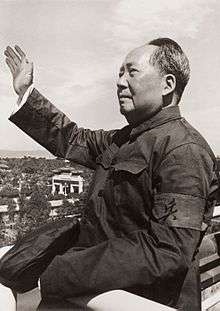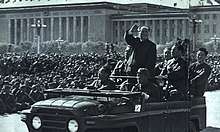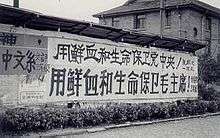Red August
The Red August (simplified Chinese: 红八月; traditional Chinese: 紅八月; pinyin: Hóng Bāyuè), originally meaning August 1966 of the Cultural Revolution, is also used to indicate a series of massacres in Beijing which mainly took place during the period.[1][2][3][4][5] According to the official statistics in 1980, from August to September in 1966, a total of 1,772 people—including teachers and principals of many schools—were killed in Beijing by Red Guards; in addition, 33,695 homes were ransacked and 85,196 families were forced to leave the city.[1][6][7][8][9] The killing by the Red Guards also made an impact on several rural districts of Beijing, causing the "Daxing Massacre", for example, during which 325 people were killed from August 27 to September 1 in Daxing District of Beijing.[2][6][10] The oldest killed during the Daxing Massacre was 80 years old, while the youngest was only 38 days old; 22 families were wiped out.[1][6][11] Scholars have also pointed out that, according to the official statistics in 1985, the actual death toll during the Red August was over 10,000.[8][12][13]

On August 18, 1966, Mao Zedong met with Song Binbin, a leader of the Red Guards, on Tiananmen of Beijing, which greatly encouraged the Red Guards who then started their massive killing in the city and destroyed the "Four Olds" at the same time.[1][6][11] Methods of slaughter during the Red August included beating, whipping, strangling, trampling, boiling, beheading and so on; in particular, the method used to kill most infants and children were knocking them against the ground or slicing them in halves.[11][14][15][16] Many people, including the notable writer Lao She, committed suicide after being persecuted.[2][17] During the massacres, Mao Zedong publicly opposed any government intervention to the student movement, and Xie Fuzhi, the Minister of Ministry of Public Security, also ordered to protect the Red Guards and not arrest them.[18][19][20][21][22] However, the situation had grown out of control by the end of August 1966, forcing the Central Committee of the Communist Party of China (CPC) and Chinese government to take multiple interventions that gradually brought the massacre to an end.[21][23]
The Red August of Beijing is regarded as the origin of Red Terror in the Chinese Cultural Revolution, instigating Red Guards' movement in multiple cities including Shanghai, Guangzhou, Nanjing and Xiamen, where local political leaders, intellectuals, teachers and members of the Five Black Categories were persecuted and even killed by the Red Guards.[1][24][25][26][27][28] There has been comparison between the date "18 August 1966", which was the crucial moment of the Red August, with the Kristallnacht, which was the prelude of Nazi Germany's Holocaust.[26][29][30][31][32][33] In addition, the Red August along with the subsequent massacres across China during the Cultural Revolution has been compared to the Nanjing Massacre conducted by the Japanese military during the Second Sino-Japanese War.[30][31][32][34][35]
History of the massacre
Historical background

On May 16, 1966, Cultural Revolution began in mainland, China. On August 5, Bian Zhongyun, the first vice principal of the Experimental High School Attached to Beijing Normal University, was beaten to death by Red Guards and was the first education worker in Beijing killed by the Red Guards.[1][7][14][21][28][36]
Massacre in Beijing
On August 18, 1966, Mao Zedong met with Song Binbin, a leader of the Red Guards, on Tiananmen of Beijing, where Mao asked Song if the "Bin" in her given name was the same Chinese character as that in Chinese Chengyu "Wen Zhi Bin Bin (文质彬彬)"; upon receiving confirmation, Mao commented that, “Yao Wu Ma (要武嘛)”, meaning "(you'd) better fight".[1][9][11][14] After this meeting, the morale of the Red Guards was boosted significantly, triggering their massive slaughter in Beijing.[1][11] In particular, on August 25, 1966, thousands of Red Guards started a week-long massacre in Ganlan Market (榄杆市) of the Chongwen District.[11][21][37] At the same time, the Red Guards began to destroy the "Four Olds".[1][11]
On August 22, 1966, Mao approved a document from the Ministry of Public Security, ordering "do not use police force—no exception—to intervene or suppress the movement of revolutionary students".[5][38][39] The next day, Mao gave a talk at a Work Conference of the Central Committee of CPC, publicly backing the students' movement and opposing any intervention to the "Cultural Revolution of students":[13][19][40]
In my view, Peking is not all that chaotic. The students held a meeting of 100,000 and then captured the murderers. This caused some panic. Peking is too gentle. Appeals have been issued, [but after all] there are very few hooligans. Stop interfering for the time being. It is still too early to say anything definite about the reorganization of the centre of the [Youth] League; let us wait four months. Decisions taken hurriedly can do only harm. Work teams were dispatched in a hurry; the left was struggled against in a hurry; meetings of 100,000 were called in a hurry; appeals were issued in a hurry; opposition to the new municipal [party] committee of Peking was said, in a hurry, to be tantamount to an opposition to the [party] Centre. Why is it impermissible to oppose K? I have issued a big character poster myself, ‘Bombard the Headquarters!’ Some problems have to be settled soon. For instance, the workers, peasants, and soldiers should not interfere with the students’ great Cultural Revolution. Let the students go into the street. What is wrong with their writing big-character posters or going into the street? Let foreigners take pictures. They take shots to show aspects of our backward tendencies. But it does not matter. Let the imperialists make a scandal about us.
On August 26, Xie Fuzhi, the Minister of Ministry of Public Security, also ordered to protect the Red Guards and not arrest them; he stated that it was not incorrect for the Red Guards to beat "bad people", and it was fine if the "bad people" were killed.[20][21][22] The next day, the "Daxing Massacre" occurred in Daxing District of Beijing.[6][2][10] While meeting with the heads of several provincial public security systems, Xie reiterated his points that the killing by Red Guards was none of their business and it would be a mistake if the public security was to arrest the Red Guards.[5][20][21][39]
The end of the massacre

By the end of August 1966, the situation had grown out of control, forcing the Central Committee of CPC and the Chinese government to take multiple interventions, which gradually brought the massacre to an end.[21][23] On September 5, People's Daily published an article (用文斗, 不用武斗), calling for an end to the combat and massacre.[41]
Nevertheless, millions of Red Guards continued to arrive in Beijing to see Mao Zedong at Tiananmen square on several occasions including September 15, October 1 and so on.[22]
The slaughter

Methods of killing
During the Red August, methods of slaughter used by the Red Guards included beating, whipping, strangling, trampling, boiling, beheading and so on; in particular, the method used to kill most infants and children were knocking them against the ground or slicing them in halves.[11][14][15][16]
Death toll
- According to the official statistics in 1980, from August to September in 1966, a total of 1,772 people—including teachers and principals of many schools—were killed in Beijing by Red Guards; in addition, 33,695 homes were ransacked and 85,196 families were forced to leave Beijing.[1][6][7][8][9]
- In "Daxing Massacre", 325 people were killed from August 27 to September 1 in Daxing District of Beijing.[6][2][10] Even though most researchers think that the number of deaths in Daxing massacre was already counted in Beijing's total tally (i.e., 1,772), some researchers disagree and argue that the number of deaths in rural districts such as Daxing and Changping were not counted in Beijing's municipal data.[42]
- Researchers have pointed out that, according to the official statistics in 1985, the actual death toll during the Red August was over 10,000; in addition, 92,000 homes were ransacked and 125,000 families were forced to leave the city.[8][12][13]
Aftermath and influence

The Red August of Beijing is regarded as the origin of Red Terror in the Chinese Cultural Revolution.[1][24][25][36] Some of the Red Guards from Beijing No.6 High School even wrote "Long Live Red Terror!" on the wall with the blood of their victims.[43]
The Red August instigated the movement of Red Guards in multiple cities of China, including Shanghai, Guangzhou, Nanjing and Xiamen, where local political leaders, intellectuals, teachers and members of the Five Black Categories were persecuted and even killed by the Red Guards.[25][27][28][31] For instance, on September 15, 1966, eleven Red Guards from Beijing Foreign Studies University went to Shanghai and teamed up with Red Guards from Shanghai Foreign Language School, chanting "Long Live Red Terror" and persecuting 31 teachers in total.[31]
There has been comparison between the date "18 August 1966", which was the key point during the Red August, and the Kristallnacht, which was the prelude of Nazi Germany's Holocaust.[26][29][30][31][32][33] Moreover, the Red August along with the subsequent massacres across China during the Cultural Revolution has also been compared to the Nanjing Massacre conducted by the Japanese military during the Second Sino-Japanese War.[30][31][32][34][35]
See also
References
- Wang, Youqin (2001). "Student Attacks Against Teachers: The Revolution of 1966" (PDF). University of Chicago. Archived (PDF) from the original on 2020-04-17.
- "A Massacre in Daxing County During the Cultural Revolution". Chinese Law & Government. 14 (3): 70–71. 2014-12-07. doi:10.2753/CLG0009-4609140370.
- Phillips, Tom (2016-05-11). "The Cultural Revolution: all you need to know about China's political convulsion". The Guardian. ISSN 0261-3077. Archived from the original on 2019-12-08. Retrieved 2019-12-23.
- Dong, Yifu. "My Grandfather Survived China's Cultural Revolution. Why Does He Still Love Mao?". Foreign Policy. Archived from the original on 2019-12-24. Retrieved 2019-12-23.
- Jian, Guo; Song, Yongyi; Zhou, Yuan (2006-07-17). Historical Dictionary of the Chinese Cultural Revolution. Scarecrow Press. ISBN 978-0-8108-6491-7. Archived from the original on 2020-06-11. Retrieved 2020-07-10.
- Jian, Guo; Song, Yongyi; Zhou, Yuan (2015-07-23). Historical Dictionary of the Chinese Cultural Revolution. Rowman & Littlefield. ISBN 978-1-4422-5172-4.
- Wang, Jiajun (2014-09-05). "怎样反思"红卫兵"" (in Chinese). Phoenix Weekly (凤凰周刊). Archived from the original on 2017-10-16. Retrieved 2019-12-10.
- Song, Yongyi (2011). "文革中"非正常死亡"了多少人? ---- 读苏扬的《文革中中国农村的集体屠杀》". Boxun (in Chinese). Dong Xiang (动向). Archived from the original on 2019-12-10. Retrieved 2019-12-10.
- "Chinese Red Guards Apologize, Reopening A Dark Chapter". NPR.org. Archived from the original on 2020-02-14. Retrieved 2020-02-14.
- Southerl, Daniel (1994-07-18). "A NIGHTMARE LEAVES SCARS, QUESTIONS". Washington Post. ISSN 0190-8286. Archived from the original on 2019-12-24. Retrieved 2019-12-23.
- Yu, Luowen. "文革时期北京大兴县大屠杀调查". Chinese University of Hong Kong (in Chinese). Lecture Room. Archived from the original on 2019-06-09. Retrieved 2019-12-10.
- Peng, Xiaoming (2013-03-02). "记下老红卫兵的血债". Beijing Spring (北京之春) (in Chinese). Archived from the original on 2013-05-09. Retrieved 2019-12-10.
- Sai, Hongqiu. "毛泽东大笑谈杀人". Boxun (in Chinese). 北京周末诗会. Archived from the original on 2019-12-10. Retrieved 2019-12-10.
- Wang, Youqin. "Archived copy" 文革受难者 ——关于迫害、监禁和杀戮的寻访实录 (PDF) (in Chinese). University of Chicago. Archived (PDF) from the original on 2016-10-12.CS1 maint: archived copy as title (link)
- "北京大兴文革屠杀:婴儿被劈成两半". Boxun (in Chinese). 2013-08-01. Archived from the original on 2019-12-10. Retrieved 2019-12-10.
- "集体遗忘文革,无疑是一种更深远的民族公耻". Ipkmedia (光传媒) (in Chinese). Archived from the original on 2020-06-29. Retrieved 2019-12-10.
- Brady, Paul (1974). "Death and the Nobel-On Lao She's "Suicide"" (PDF). Chinese University of Hong Kong. Archived (PDF) from the original on 2019-12-27.
- Xiong, Jingming; Song, Yongyi; Yu, Guoliang (2018-06-15). 中外學者談文革 (in Chinese). Hong Kong: The Chinese University Press. ISBN 978-988-17563-3-6.
- Mao, Zedong. "Talk At The Work Conference Of The Centre". www.marxists.org. Archived from the original on 2018-07-15. Retrieved 2020-02-14.
- "文革公安部长谢富治谈红卫兵打死人:我们管不着". Phoenix New Media (凤凰网) (in Chinese). Archived from the original on 2019-12-10. Retrieved 2019-12-10.
- "卞仲耘丈夫:宋彬彬没参与打人 但她是一伙儿的". Phoenix New Media (凤凰网) (in Chinese). Archived from the original on 2019-12-10. Retrieved 2019-12-10.
- "对红卫兵组织失去信任 毛泽东决定下放知青始末". Phoenix New Media (凤凰网) (in Chinese). Renming Wang. 2009-12-14. Archived from the original on 2015-05-27. Retrieved 2019-12-10.
- Wang, Nianyi (2006-06-13). "《亲历重庆大武斗》序". China News Digest (华夏文摘) (in Chinese). Archived from the original on 2011-05-19. Retrieved 2019-12-10.
- Xiong, Jingming; Song, Yongyi; Yu, Guoliang (2018-06-15). 中外學者談文革 (in Chinese). Hong Kong: The Chinese University Press. ISBN 978-988-17563-3-6.
- "47周年回放:再忆文革"八.一八"和 "红八月"". Radio Free Asia (in Chinese). 2013-08-15. Archived from the original on 2019-12-10. Retrieved 2019-12-10.
- Jin, Zhong. "红八月,血迹未乾". Independent Chinese PEN Center (in Chinese). Archived from the original on 2019-12-10. Retrieved 2019-12-10.
- "1966年首都红卫兵上海搞武斗:没打死就是文斗". Tencent (in Chinese). Century (世纪). 2013-09-28. Archived from the original on 2020-06-12. Retrieved 2019-12-10.
- Wang, Youqin. "Archived copy" 卞仲耘纪念文章(续) (in Chinese). University of Chicago. Archived from the original on 2019-12-11. Retrieved 2019-12-10.CS1 maint: archived copy as title (link)
- "王容芬经历的"8·18"". Deutsche Welle (in Chinese). 2011-08-19. Archived from the original on 2019-12-10. Retrieved 2019-12-10.
- Wang, Chuanye. "沉重的回忆(41)"文革"风暴到来的时候". Chinese University of Hong Kong (in Chinese). Archived from the original on 2020-03-24. Retrieved 2019-12-10.
- Xi, Ligong (2012). "也说"老红卫兵"". Boxun (in Chinese). Archived from the original on 2019-12-10. Retrieved 2019-12-10.
- Lang, Jun (2012). "伫视王晶垚-宋彬彬对簿历史的公堂——《宋彬彬谈话纪要》的解读及其它(下)". China News Digest (华夏文摘) (in Chinese). Archived from the original on 2019-12-11. Retrieved 2019-12-10.
- Ma, Sheng-Mei (1987-01-01). "Contrasting Two Survival Literatures: On the Jewish Holocaust and the Chinese Cultural Revolution". Holocaust and Genocide Studies. 2 (1): 81–93. doi:10.1093/hgs/2.1.81. ISSN 8756-6583.
- Luo Ri, Yu Deng (2018-12-13). "讀者來函:建構文化創傷——從南京大屠殺與「文革」說起". Initium Media. Archived from the original on 2019-12-11. Retrieved 2019-12-10.
- Ma, Jian (2016). "谁敢把皇帝拉下马?----文革五十周年反思". Independent Chinese PEN Center (in Chinese). Archived from the original on 2020-06-28. Retrieved 2019-12-10.
- Lasseter, Tom. "Chinese haunted by bloody 'Red August'". Austin American-Statesman. Archived from the original on 2020-06-12. Retrieved 2020-06-12.
- "榄杆市事件". Sohu (in Chinese). 2019-05-31. Archived from the original on 2019-12-10. Retrieved 2020-02-14.
- "47周年回放:再忆文革"八.一八"和 "红八月"". Radio Free Asia (in Chinese). Archived from the original on 2019-12-10. Retrieved 2020-02-14.
- Xiong, Jingming; Song, Yongyi; Yu, Guoliang (2018-06-15). 中外學者談文革 (in Chinese). Hong Kong: The Chinese University Press. ISBN 978-988-17563-3-6.
- Mao, Zedong. "在中央工作会议上的讲话(一九六六年八月二十三日)". 中文马克思主义文库 (in Chinese). Archived from the original on 2019-12-10. Retrieved 2019-12-10.
- Yang, Jishen (2017-07-04). 天地翻覆: 中国文化大革命历史 (in Chinese). 天地图书.
- Du, Junfu (2012). "文革屠杀事件注记二则" (PDF). Remembrance (in Chinese). 83. Archived (PDF) from the original on 2020-04-12. Retrieved 2020-04-14.
- Youqin, Wang. "学生王光华之死". The University of Chicago (in Chinese). Archived from the original on 2018-12-26. Retrieved 2019-12-10.